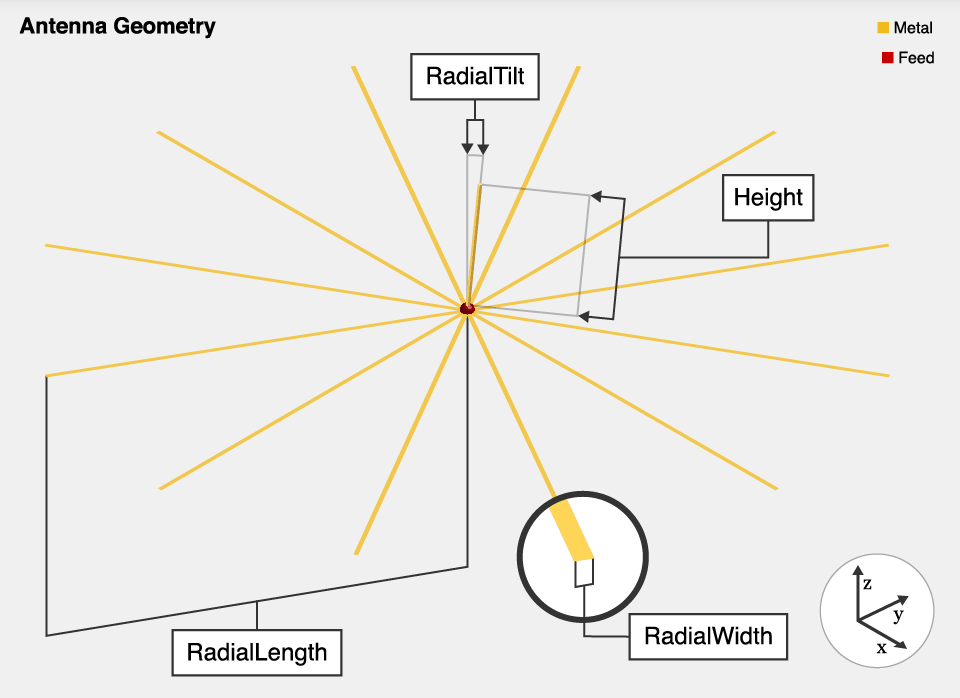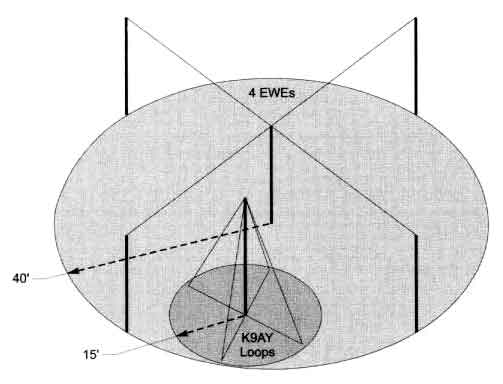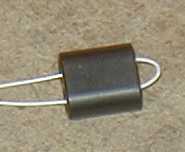
Is it permissable to have both elevated and ground radials?
Yes. But with only a few radials (less than about 8 radials per antenna) any radials contacting or very near earth will reduce system efficiency.
- Does a ground rod at the juncture of the radials hurt or hinder?
With less than about 8 elevated radials, a ground rod connected at the common junction of radials absolutely hurts FS! That is a simple measurement. I added a jumper connecting three six foot (or so) ground rods to the common point of the radials, and measured a quite noticeable FS loss!
- Should the coax shield be left “floating” to the radials or grounded?
With a small elevated system, the shield absolutely must float off of any ground connection along with the radials for maximum efficiency. The feedline needs a choke balun to prevent current from flowing down the outside of the shield. Keep in mind even when I did that, efficiency was still not good compared to the same system with more radials.
- Does it help to tune the radials with a meter such as an Autek or doesnt it matter.
I tuned the radials I had, because the velocity factor in the wire is reduced by ground losses. I had no idea how much the added loss of the soil would change the Vp in the wires. A resonant radial wound up being a bit shorter than 234/f. I tuned my radials by using opposite pairs as a temporary low dipole.
- On short elevated radials does it help to load them with a coil?
It doesn’t help at all from one standpoint. It is no different that adding a coil to the radiator. Remember the feedpoint is in series with the antenna and the radials. Which side of the feedpoint the coil goes on makes no difference at all, if the feedline is isolated with a choke balun.
If the feedline is NOT isolated with a choke balun, coil location affects efficiency and resonance. The coil belongs on the radials. But in this case, efficiency suffers even more because the ground path through the coax to earth ground adds loss.
The poorest antenna I measured had four 1/8 wl radials carefully resonated with a high Q (Q>400) inductor. It was the most critical for feedline grounding (or ground rod grounding), and even when isolated as much as I could muster with two feedline chokes never equaled or exceeded two or four elevated full sized radials. It also had less bandwidth.
Four elevated radials in an optimized system was about 5 dB down from 60 radials just laying on or buried in the earth, and with 60 radials I didn’t need to worry about grounding the radials.
This doesn’t prove elevated radials can never “work”, it just proves they didn’t work efficiently here (and at two other locations) no matter how much care I put in the system….. unless I used more than 20 or 30 radials. I believe the military tested elevated radials (as reported by N7CL) and there results were almost exactly the same as my results.
A W0 on 40 meters also reported he replaced an elevated system at a BC station in Indiana, and found the same thing as I did. He said they had to explain to the FCC how they suddenly picked up several dB in FS from a system (the elevated system) that was supposed to be perfect. The BC station I replaced radials at used six elevated radials per tower, and gained between 3 and 7.5 dB at all the field proof points after the change, despite the fact it was represented as 100% efficient when it used the elevated system.
LB mentioned inefficiency of elevated radials is related to the “unbalance” of current in radials. I disagree with that one statement. Radiation is not a major source of system loss, no matter what a current meter indicates, unless the radials are a long distance above earth or unless a greatly non-symmetrical elevated radial system is used.
- Cancellation of radiation and induction fields is a distance related problem. No matter how well current is “balanced” in radials, radials couple to via radiation anything between zero and several radial lengths away in some directions. They also couple to anything within a large fraction of a wavelength away by induction fields, even if current is perfectly balanced. Assume we have a pair of 1/4 wl long radials on 160 meters, 120 feet long. If current is perfectly balanced, radiation and induction fields only cancel more than a wavelength or so from the two radials in most directions! That’s several hundred feet. Distance to the far point has to be essentially equal to all area with equal and opposite charges and charge movements, otherwise coupling occurs. For example? Assume we are 1/2 way out on one radial at ground level, and the radial is ten feet high. We are only TEN FEET from one area of one radial, and 120 feet from the area carrying equal and opposing currents! No way does radiation cancel at all, nor do induction fields cancel. That radial drives the earth below it almost like the other radial does not exist, except the other radial reduces the driving current by half. Losses would be (considering only current) reduced only six dB by the second radial over just a single radial. Of course that is an less than ideal analysis that considers only current. With 60 radials, current density would be 1/60th value using a single radial. Losses are reduced by the square of the current density, or 3600 times (reduced almost 35 dB). The above is oversimplified, but it still illustrates the great power loss difference possible when current is spread out instead of being concentrated in one area of a lossy media. In other directions, with only a few radials, radiation NEVER completely cancels no matter what the distance. That’s why a 1/4 groundplane with four perfectly spaced and equal current radials has a distorted pattern. Of course the effect is worse when the antenna is jammed down against earth, and that’s why ALL the knowledgeable books always cautioned a ground plane antenna needed to be at least 1/2 wl above earth. Those old guys had to use meters, because they didn’t have computers! The key to remember is distance. The distance from the point of interest to areas of the conductors (radials) carrying equal and opposite charges or charge movements has to be exactly the same in order for complete cancellation to occur. The coupling to earth is essentially the same whether currents are balanced or not, although earth losses might be reduced IF the earth below and around the wires is homogeneous and there are no other conductors coupling to radials. I doubt anyone has that situation.
- If the earth below or anywhere near the radials is NOT homogeneous, and if there are other conductors around the radials, minimum far-field will occur when the radials are intentionally unbalanced. If the environment is not perfect, re-radiation from the radial’s surroundings will NOT be equal. Balanced current will guarantee far-field radiation in this condition, which I suspect is an extremely common situation. As a matter of fact the tendency of radials is they have the LEAST current in the least effective radials. Current actually moves into the “more effective” radials all on its own. Forcing current to be equal can actually move current into the areas of greatest loss, and accomplish exactly the opposite of what has been theorized, since the bulk of losses are near field losses and are NOT affected by far-field cancellation of radiation.
- There is absolutely nothing that indicates lack of efficiency is do to anything more than not enough radials, which simply means current density in the lossy soil below the radials is concentrated in a smaller area. Concentrated current (and electric fields) always increases loss for a given media surrounding the antenna.
I’d like to remind everyone again, that NONE of the recent counterpoise articles have supporting field strength data of actual A-B tests on one system…not even a crude test. Without supporting data, this stuff is all just a personal opinion of what might really be happening.
Because of the complexities involved in near field losses, even if one system works (and even if it does NOT work) no one can say the same applies to other systems. This is especially true in a small area with all kinds of other conductors around the antenna.
My measurements don’t prove elevated systems never work. They simply prove they didn’t work for me (and for a few other cases) no matter how carefully they are installed. This was true in an open pasture with nothing else around for a wavelength or more, and in two rocky soil environments.
The only thing we know for sure is that when a large number of radials are used, the system becomes non-critical and virtually always works at the maximum efficiency possible for a given location. With only sixty radials 1/4 wl long, it has been proven time and time again efficiency approaches 100%. That we know.
The rest is all guesswork. Unfortunately the guesswork disagrees with physics that works perfectly for everything else in the world.
I used to install radio stations, two way communications systems, and CATV systems. We almost never had failures from lightning even with hundreds of sites, many of which suffered direct hits. The key is more in how the site is wired than in fancy gimmicks.
Naturally, we are going over our grounding system to ensure that we do all that can possibly be done in an effort to avoid a recurrence.
If you want to be safe, bring ALL cables that enter the building through a metal bulkhead. Use grounded connectors at the bulkhead, and protect telephone and power mains wires with MOV’s.
Every cable entering the bulkhead should have a solenoid winding using a few turns of conductor, spaced a few feet away from other cables and suspended in air. The cables should be buried for some distance before entering the building.
If you can not bury the feedline, at least add a single large loop of coax. DO NOT ground the tower grounds to the building grounds, unless they are closer than 50 – 100 feet to each other. If they are close, bond the tower to the station ground and install a large ground mat of heavy copper wire. Number eight AWG wire is fine buried in straight lines away from the building and tower.
Use multiple deep rods, spaced several feet apart connected with wide copper flashing. NEVER use braiding for ground leads. Your little (even though wet) ground rod is like having nothing at all for a ground!
Remember, everything (and that includes plumbing or any other conductors) must enter the building near the bulkhead, and be securely grounded to the bulkhead with wide copper flashing. It is critical that coax connectors be properly installed, grounded to the tower where they leave the tower (at ground level) and tightened properly. Adding lightning surge protectors is a waste of time and money on coaxial lines IF they are properly installed and maintained.
If you can get a copy of the NAB Broadcast Handbook, it details proper station design.
- Watering to keep the soil around the copper rod always wet. The 7/8-inch heliax feeder was also grounded to the tower at the top and also at a point further down where it bends to leave the tower to enter the transmitter room.
I hope the heliax does not leave the tower above ground level, unless you have it grounded at multiple points after it leaves the tower!
- Since the lightning strike, we have checked all connections to ensure that contacts are good and have now installed a 10mm copper cable diretcly from the lightning arrester to the copper in the earth.
Probably a waste of time. The tower is already a good wide conductor for lightning.
- We have also ordered a surge protector which will be installed on the mains coming into the building.
Good idea. Just make sure the power lines, feedlines, telco lines, and even plumbing all enters at the same area and ALL are securely bonded to each other. DO NOT run a separate ground into the building from the tower to a rack!!!!! Everything inside the building can be grounded to the bulk head, and the bulk head grounded to earth. But never ever run any isolated lead that is not tied to the bulk head outside the building!!
- Questions: I can ground to the top of the building, but what should I do about radials?
If you use resonant elevated radials, and only a few radials, grounding to the building can actually HURT your signal. Expect about 4 to 8 dB less signal with a small elevated system when compared to a big regular radial system, no matter what fancy tricks are used to improve performance.
I’d recommend grounding to the building and adding a bunch of radials (at least 30) either elevated or laying on the ground. Use as many as you can as straight and long as you can reasonably make them.
- Performance wise it seems to beat the slopers, dipoles and other cloud warmers. It will not compete with the beams, but there are not that many beams on 80 meters anyway.
I don’t know how this relates to 80 meters, but I have extensive 160 meter data taken during a series of tests morning after morning on 160 meters with VK3ZL and ZL2REX, and other DX stations.
I have a pair of phased dipole at 250 feet on 160 meters. That certainly must qualify as a beam of some sort, since it shows about 5 dB gain over a single dipole at 250 feet.
My four square equals or beats the high phased dipoles 72% of the time when I include the sunrise band peaks. When I toss those peak times out of the data, the four square beats the dipoles about 97% of the time.
These numbers are based on over 400 reports from DX on 160 meters collected over a six month period.
With a poor ground system, it is the other way around. Using four elevated radials on a test vertical, a high dipole “whipped the stuffing” out of the vertical time after time. The VERY SAME dipole never beat a vertical with 60 1/4 wl radials, unless it was a QSO within a few hundred miles.
A field strength meter confirmed a six dB change in FS by adding 60 radials slightly buried, when compared to the same antenna with four elevated radials. I never measured one radial, but with two radials FS approached 10 dB down. This was with an antenna in a absolutely clear open pasture.
- Oh!… I forgot to mention the sloping part. ON4UN states that if you come more that 19-20 degrees off vertical you loose the vertical component.
The vertical radiation, when sloping a wire some angle off true vertical, is always attenuated less than the cosign of the angle. For example, at 45 degrees of slope field attenuation is: cos45 log20 or .707 (the cosign of the angle 45 degrees) times log20 (the formula for voltage change expressed as dB). Radiation is 3 dB down or less with a wire slope of 45 degrees. 20 degrees off vertical, radiation would be cos of 20 times log 20, or .54 dB down in the worse case possible. The antenna does not loose significant vertical component until the angle approaches 45 degrees. This is the same thing that makes an inverted V remain mostly horizontally polarized with apex angles of more than 90 degrees.
- I use only one radial. There is not that much advantage to adding more radials.
Except about a ten or twenty-fold increase in efficiency! I can’t imagine a single radial working efficiently, even over salt water.
Author wanted! I got this text somewhere on the Internet but I don’t know who is the author. I will be pleased to include his name here.



